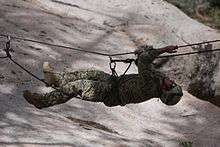Tyrolean traverse



A Tyrolean traverse is a method of crossing through free space between two high points on a rope without a hanging cart or cart equivalent. This is used in a range of mountaineering activities: rock climbing, technical tree climbing, caving, water crossings and Mountain Rescue. A zip-line is in essence a Tyrolean traverse which is traveled down quickly with the assistance of gravity. Several sources claim that the name comes from the Tyrolean Alps, where climbers are said to have developed the system in the late nineteenth and early twentieth centuries.[1][2][3]
In rock climbing a Tyrolean traverse is most often used to return to the main part of a wall after climbing a detached pillar. Lost Arrow Spire, a detached pillar in Yosemite Valley, is often abseiled using a dramatic Tyrolean traverse. There are many ways to anchor the line at the two high points but the significant feature is that there is a line strung between them.[4]
Many classic locations for Tyrolean traverses have since been used as locations for "highlining" or "slacklining" (techniques which involve walking across the line like a tightrope, rather than hanging beneath) at great heights. In a sense completing such a slackline would count as a Tyrolean traverse but since slacklines are not typically used as a form of transportation this is not entirely accurate. With the rise in popularity of slacklining and the relative decline in the use of Tyrolean traverse by the climbing community the terms "highlining" and "Tyrolean traverse" have been somewhat confused due to obvious overlaps in the nature of the activity, including preparation and location.
Traveling across a Tyrolean traverse varies from purely using one's hands and legs to the use of prusiks, one way pulleys, or ascenders. In most modern situations the traverser is secured to the line through some combination of climbing harness, webbing, carabiner, and/or pulleys.
There are situations in which a Tyrolean traverse is the preferred way to descend a route, a Tyrolean traverse may allow a climber to avoid a long multi-pitch rope rappel in favor of a walk-off (walking descent); or a Tyrolean traverse may allow the climber to avoid an undesirable or dangerous location such as a steep scree field.
The longest Tyrolean traverse agreed by Guinness is 1550 meters. It was created on 19.09.2008 in Rila mountain Bulgaria.[5] Another famous Tyrolean traverse, set up in 2000, connected Castleton Tower and Rectory desert towers, which are about 500 meters apart.[6]
A famous use of a Tyrolean traverse in popular culture was in the opening scene of the 1993 Sylvester Stallone film "Cliffhanger", where a mountain rescue climber (played by Stallone) unsuccessfully attempts to transport a woman across a high Tyrolean traverse, only to have her fall to her death.[7] This scene was later spoofed in the Jim Carrey comedy film "Ace Ventura: When Nature Calls".
References
- ↑ Outdoor Fun Store. "History of The Zipline". Archived from the original on February 25, 2012. Retrieved 27 August 2013.
- ↑ "Uncle Ezra". "Dear Uncle Ezra: Questions for Thursday, April 7, 2011". Dear Uncle Ezra. Cornell University. Archived from the original on June 6, 2013. Retrieved 27 August 2013.
- ↑ "Does the Tyrolean crossing (zip line) from Tyrol?". Skeptics Stack Exchange. stack exchange inc. Retrieved 27 August 2013.
- ↑ Mountaineering: The Freedom of the Hills (6th Revised ed.), Swan Hill Press, 1997-10-14, ISBN 978-1-84037-001-0
- ↑ "Longest Tyrolean traverse". Guinnessworldrecords.com. Retrieved 2016-01-19.
- ↑ "Castleton – Rectory tyrolean traverse". Climbing (197): 40. September 2000.
- ↑ "Reading Eagle - Google News Archive Search". news.google.com. Retrieved 2015-11-12.
| Wikimedia Commons has media related to Tyrolean crossing. |